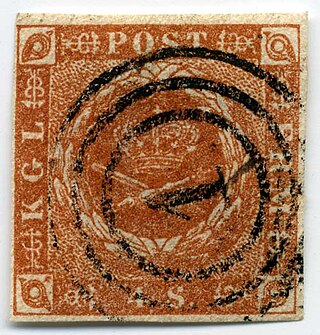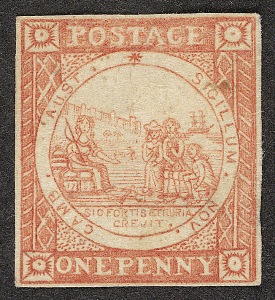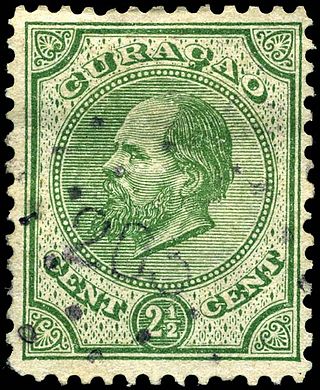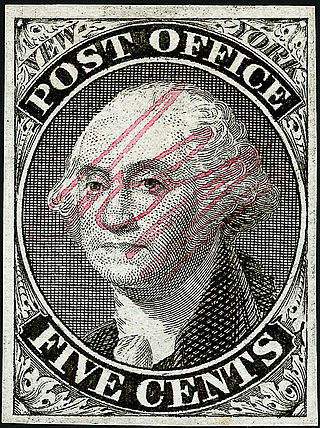


Bermuda, a group of islands in the North Atlantic Ocean, was previously uninhabited when the British established a settlement in 1612.



Bermuda, a group of islands in the North Atlantic Ocean, was previously uninhabited when the British established a settlement in 1612.
In its isolated location, the colony originally depended on packet ships for mail, connecting via St Thomas, New York City, or Halifax at different periods. A packet agent managed external mails from 1818, with packet handstamps known from 1820. [1]
The Bermuda Gazette operated a domestic mail service from 1784, later taken over by the local government. In 1859, both internal and external mail service became the colony's responsibility, with the chief postmaster being based at St. George's. [1]
Bermuda's first postage stamps were produced locally in 1848 by Hamilton postmaster William B. Perot, consisting of the words "HAMILTON BERMUDA" in a circle, with the year and Perot's signature in the middle. Known as the Perot provisionals, they are among the great rarities of philately. A crown-in-circle design used at St. George's in 1860, also rare, is attributed to postmaster James H. Thies.
General stamp issues began in 1865, with a set of three (1d, 6d, and 1sh), each with a different design based on the profile of Queen Victoria. These were supplemented with 2d and 3d values in 1866 and 1873.
In 1902, Edward VII was not honored with a depiction on new stamps; instead the issue depicted a Bermudian dry dock, and remained in use throughout his reign. These were the first stamps in the British Empire that did not depict the monarch's head. [2]
The unusual practice continued, at least in part, with George V of the United Kingdom, with the low values of the issue of 1910 depicting the seal of the colony (a caravel), while the higher values (2sh and up) were large-format designs featuring the king's profile.
Bermuda's first commemorative stamps were an issue of 1920, marking the 300th anniversary of representative institutions. The design consisted of the caravel seal and a profile of George V, with the inscriptions "BERMUDA COMMEMORATION STAMP" above and "TERCENTENARY OF ESTABLISHMENT OF REPRESENTATIVE INSTITUTIONS" below. A second issue, in 1921, commemorated the same occasion with a completely different design, with George V in the centre and various symbols in the corners. [3]
Bermuda issued a pictorial series of stamps in 1936, consisting of nine stamps with seven different designs depicting local scenery. Several of the designs were reused, and three more added, for a 1938 issue featuring George VI.
A commemorative issue of 1949 marked the 100th anniversary of Perot's provisional stamp.

A postage stamp is a small piece of paper issued by a post office, postal administration, or other authorized vendors to customers who pay postage. Then the stamp is affixed to the face or address-side of any item of mail—an envelope or other postal cover —which they wish to send. The item is then processed by the postal system, where a postmark or cancellation mark—in modern usage indicating date and point of origin of mailing—is applied to the stamp and its left and right sides to prevent its reuse. Next the item is delivered to its addressee.

The postal and philatelic history of Canada concerns postage of the territories which have formed Canada. Before Canadian confederation, the colonies of British Columbia and Vancouver Island, Prince Edward Island, Nova Scotia, New Brunswick and Newfoundland issued stamps in their own names. The postal history falls into four major periods: French control (1604–1763), British control (1763–1841), colonial government control (1841–1867), and Canada, since 1867.

Postal service in the United States began with the delivery of stampless letters whose cost was borne by the receiving person, later encompassed pre-paid letters carried by private mail carriers and provisional post offices, and culminated in a system of universal prepayment that required all letters to bear nationally issued adhesive postage stamps.

Indian postal systems for efficient military and governmental communications had developed long before the arrival of Europeans. When the Portuguese, Dutch, French, Danish and British conquered the Marathas who had already defeated the Mughals, their postal systems existed alongside those of many somewhat independent states. The British East India Company gradually annexed the other powers on the sub-continent and brought into existence a British administrative system over most of modern-day India, with a need to establish and maintain both official and commercial mail systems.

This is an overview of the postage stamps and postal history of Denmark.

Postage stamps and postal history of Great Britain surveys postal history from the United Kingdom and the postage stamps issued by that country and its various historical territories until the present day.

This is a survey of the postage stamps and postal history of the Falkland Islands.

This is an overview of the postage stamps and postal history of Australia.

This is a survey of the postage stamps and postal history of New South Wales, a former British colony now part of Australia.

The Trans-Mississippi Issue is a set of nine commemorative postage stamps issued by the United States to mark the 1898 Trans-Mississippi Exposition held in Omaha, Nebraska. The finely engraved stamps depict various scenes of the West and are presently valued much by collectors. This was only the second commemorative issue offered by the U.S. Post Office and closely followed the pattern of its predecessor, the Columbian Exposition series of 1893: both sets appeared in conjunction with important international world's fairs; both offered a wide range of stamp denominations; both adopted the double-width stamp format to accommodate pictorial tableaux.

This is a survey of the postage stamps and postal history of the Gilbert and Ellice Islands.

This is a survey of the postage stamps and postal history of the postal areas Netherlands Antilles as well as its predecessor Curaçao. The area consisted of the islands Bonaire, Saba and Sint Eustatius as well as Sint Maarten, Curaçao and Aruba.
This is a survey of the postage stamps and postal history of Hong Kong.

The postage stamps of Ireland are issued by the postal operator of the independent Irish state. Ireland was part of the United Kingdom of Great Britain and Ireland when the world's first postage stamps were issued in 1840. These stamps, and all subsequent British issues, were used throughout Ireland until the new Irish Government assumed power in 1922. Beginning on 17 February 1922, existing British stamps were overprinted with Irish text to provide some definitives until separate Irish issues became available within the new Irish Free State. Following the overprints, a regular series of definitive stamps was produced by the new Department of Posts and Telegraphs, using domestic designs. These definitives were issued on 6 December 1922, the day that the Irish Free State officially came into existence; the first was a 2d stamp, depicting a map of Ireland. Since then new images, and additional values as needed, have produced nine definitive series of different designs.

The postal history of Malta began in the early modern period, when pre-adhesive mail was delivered to foreign destinations by privately owned ships for a fee. The earliest known letter from Malta, sent during the rule of the Order of St John, is dated 1532. The first formal postal service on the islands was established by the Order in 1708, with the post office being located at the Casa del Commun Tesoro in Valletta. The first postal markings on mail appeared later on in the 18th century.

This is a survey of the postage stamps and postal history of Jamaica.

The postal history of the Pitcairn Islands began with letters being sent without postage stamps, as none were available on Pitcairn. In 1921, the United Kingdom and New Zealand formally agreed upon a system to handle post from the island, but this arrangement was ended in 1926. In 1927, stamps from New Zealand were introduced. To improve the revenue generation of the colony, the British government established an official post office on the island in 1940. The opening of this post office saw the issuance of the first set of Pitcairn Islands stamps.
Belize started as the colony of British Honduras, formally established in the 17th century but disputed through the 18th century.

This is a survey of the postage stamps and postal history of Saint Helena.

The New York Postmaster's Provisional is, as its designation implies, a postage stamp provided by the New York Post Office to facilitate the prepayment of mail at a time when the United States had not yet issued postage stamps for national use. Placed on sale on July 14, 1845, this was the nation's first provisional stamp to be issued by a local post office in response to the congressional postal reform act that had taken effect two weeks earlier. That law, passed on March 3, 1845, standardized nationwide mail rates, with the result that the use of stamps became a practical and reliable method of postal prepayment. Before standardization, the many different postal rates in different jurisdictions had made fees too unpredictable to prepay all letters with stamps as a matter of course, with the result that recipients of letters—rather than senders—generally paid the postage on them. Baltimore announced the issue of a provisional stamp one day after New York, on July 15, and New Haven soon followed. The New York issue has been cited as "the most elegantly executed and widely used of the group of provisionals issued by eleven different [U. S. post] offices between 1845 and 1847."